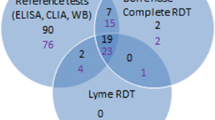Abstract
Bloodstream invasion is an important event in the pathogenesis of the more serious manifestations of Lyme disease. The number of spirochetes in the blood of infected patients, however, has not been determined, and, therefore, it is unknown whether the number of spirochetes can be correlated with particular clinical or laboratory features. This study was designed to measure the level of Borrelia burgdorferi in the plasma of Lyme disease patients and correlate these levels with selected clinical and laboratory findings. Nested and quantitative polymerase chain reaction (qPCR) was employed to detect cell-associated flaB gene DNA in the plasma of untreated early Lyme disease patients with erythema migrans (EM). Twenty-nine (45.3%) of 64 patients had evidence of B. burgdorferi in their plasma by at least one of the PCR methods. For the 22 qPCR-positive patients, the mean number of flaB gene copies per mL of plasma was 4,660, with a range of 414 to 56,000. The number of flaB gene copies did not significantly correlate with any of the clinical, demographic, or laboratory variables assessed. For reasons discussed, we suggest caution in extrapolating an estimate of the number of viable Borrelia in plasma from the observed number of flaB copies.

Similar content being viewed by others
References
Bacon RM, Kugeler KJ, Mead PS, Centers for Disease Control and Prevention (CDC) (2008) Surveillance for Lyme disease—United States, 1992–2006. MMWR Surveill Summ 57:1–9
Wormser GP, McKenna D, Carlin J, Nadelman RB, Cavaliere LF, Holmgren D, Byrne DW, Nowakowski J (2005) Brief communication: hematogenous dissemination in early Lyme disease. Ann Intern Med 142:751–755
Wormser GP (2006) Hematogenous dissemination in early Lyme disease. Wien Klin Wochenschr 118:634–637
Goodman JL, Bradley JF, Ross AE, Goellner P, Lagus A, Vitale B, Berger BW, Luger S, Johnson RC (1995) Bloodstream invasion in early Lyme disease: results from a prospective, controlled, blinded study using the polymerase chain reaction. Am J Med 99:6–12
Nadelman RB, Schwartz I, Wormser GP (1994) Detecting Borrelia burgdorferi in blood from patients with Lyme disease. J Infect Dis 169:1410–1411
Jones KL, Glickstein LJ, Damle N, Sikand VK, McHugh G, Steere AC (2006) Borrelia burgdorferi genetic markers and disseminated disease in patients with early Lyme disease. J Clin Microbiol 44:4407–4413
Liveris D, Varde S, Iyer R, Koenig S, Bittker S, Cooper D, McKenna D, Nowakowski J, Nadelman RB, Wormser GP, Schwartz I (1999) Genetic diversity of Borrelia burgdorferi in Lyme disease patients as determined by culture versus direct PCR with clinical specimens. J Clin Microbiol 37:565–569
Liveris D, Wang G, Girao G, Byrne DW, Nowakowski J, McKenna D, Nadelman RB, Wormser GP, Schwartz I (2002) Quantitative detection of Borrelia burgdorferi in 2-millimeter skin samples of erythema migrans lesions: correlation of results with clinical and laboratory findings. J Clin Microbiol 40:1249–1253
Barbour AG, Maupin GO, Teltow GJ, Carter CJ, Piesman J (1996) Identification of an uncultivable Borrelia species in the hard tick Amblyomma americanum: possible agent of a Lyme disease-like illness. J Infect Dis 173:403–409
Morrison TB, Ma Y, Weis JH, Weis JJ (1999) Rapid and sensitive quantification of Borrelia burgdorferi-infected mouse tissues by continuous fluorescent monitoring of PCR. J Clin Microbiol 37:987–992
Wang G, Ojaimi C, Iyer R, Saksenberg V, McClain SA, Wormser GP, Schwartz I (2001) Impact of genotypic variation of Borrelia burgdorferi sensu stricto on kinetics of dissemination and severity of disease in C3H/HeJ mice. Infect Immun 69:4303–4312
Fraser CM, Casjens S, Huang WM, Sutton GG, Clayton R, Lathigra R, White O, Ketchum KA, Dodson R, Hickey EK, Gwinn M, Dougherty B, Tomb JF, Fleischmann RD, Richardson D, Peterson J, Kerlavage AR, Quackenbush J, Salzberg S, Hanson M, van Vugt R, Palmer N, Adams MD, Gocayne J, Weidman J, Utterback T, Watthey L, McDonald L, Artiach P, Bowman C, Garland S, Fuji C, Cotton MD, Horst K, Roberts K, Hatch B, Smith HO, Venter JC (1997) Genomic sequence of a Lyme disease spirochaete, Borrelia burgdorferi. Nature 390:580–586
Nadelman RB, Nowakowski J, Forseter G, Goldberg NS, Bittker S, Cooper D, Aguero-Rosenfeld M, Wormser GP (1996) The clinical spectrum of early Lyme borreliosis in patients with culture-confirmed erythema migrans. Am J Med 100:502–508
Liveris D, Schwartz I, Bittker S, Cooper D, Iyer R, Cox ME, Wormser GP (2011) Improving the yield of blood cultures from patients with early Lyme disease. J Clin Microbiol 49:2166–2168
Cruz AR, Pillay A, Zuluaga AV, Ramirez LG, Duque JE, Aristizabal GE, Fiel-Gan MD, Jaramillo R, Trujillo R, Valencia C, Jagodzinski L, Cox DL, Radolf JD, Salazar JC (2010) Secondary syphilis in Cali, Colombia: new concepts in disease pathogenesis. PLoS Negl Trop Dis 4:e690
Dworkin MS, Schwan TG, Anderson DE Jr, Borchardt SM (2008) Tick-borne relapsing fever. Infect Dis Clin North Am 22:449–468
Kitten T, Barbour AG (1992) The relapsing fever agent Borrelia hermsii has multiple copies of its chromosome and linear plasmids. Genetics 132:311–324
Acknowledgments
This work was supported by the U.S. National Institutes of Health (NIH) grant AR41511. The authors thank Lisa Giarratano for her assistance.
Disclosures
G.P.W.: research grants from the Centers for Disease Control and Prevention (CDC), NIH/Immunetics, Inc., BioRad, DiaSorin, Inc., and bioMérieux; equity in Abbott (no Food and Drug Administration [FDA]-approved Lyme product to my knowledge); expert witness in malpractice cases involving Lyme disease now completed; unpaid board member of the American Lyme Disease Foundation. No disclosures for the other authors.
Competing interests
All authors have no competing interests.
Author information
Authors and Affiliations
Corresponding author
Rights and permissions
About this article
Cite this article
Liveris, D., Schwartz, I., McKenna, D. et al. Quantitation of cell-associated borrelial DNA in the blood of Lyme disease patients with erythema migrans. Eur J Clin Microbiol Infect Dis 31, 791–795 (2012). https://doi.org/10.1007/s10096-011-1376-x
Received:
Accepted:
Published:
Issue Date:
DOI: https://doi.org/10.1007/s10096-011-1376-x




